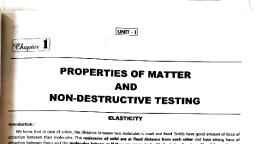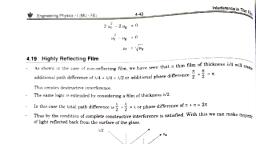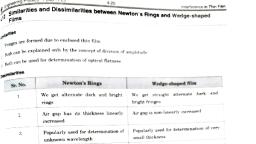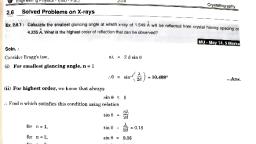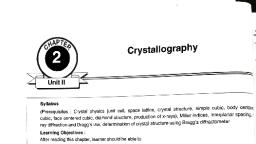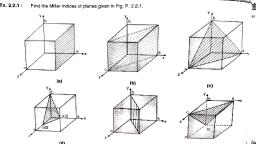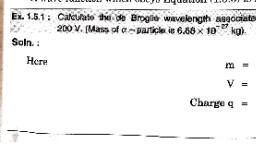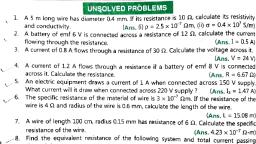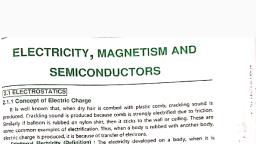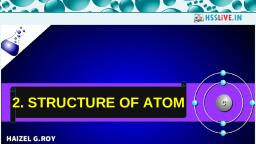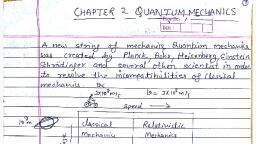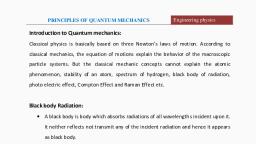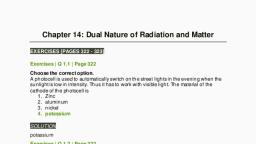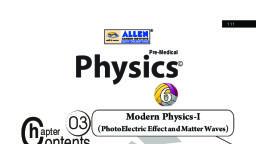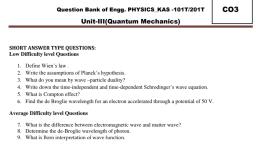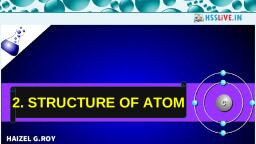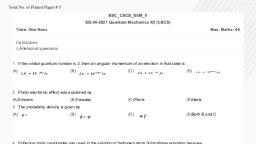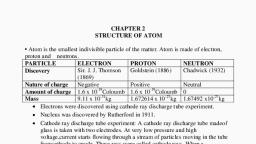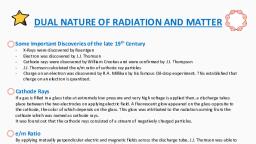Page 1 :
Quantum Mechanics, , , , yi INTRODUCTION, , 95, de Broglie introduced the concept of matter waves and the idea of wave-particle, y. He suggested that the wave-particle duality observed in case of light should be, to microparticles also. The combination of the idea of quantization with the idea of, save-particle duality proved to be very fruitful for the development of quantum mechanics. The, sole apparatus of quantum mechanics was built in 1925-26. In 1925 Heisenberg suggested, fat any reference to conceptual pictures which are not amenable to direct experimental, wenfication, should be discarded. He formulated matrix mechanics which is set in terms of the, dservable quantities alone. In 1926, Schriédinger developed wave mechanics. His theory is, tesed on explicit use of a mental picture of matter wave which replaced the classical picture, ofpoint particle. He developed the well-known differential equation for a wave function. The, poolem of calculating the energy levels of a bound microparticle was reduced by Schrédinger, io the problem of finding eigenvalues. Heisenberg’s theory came to be known as matrix, Mechanics while that of Schrédinger aS wave mechanics. In 1926, Max Born proposed the, Pobability interpretation of the wave function. In 1927 the wave behaviour of microparticles, %s confirmed by experiments on electron diffraction conducted simultaneously in several, Gffcrent laboratories. In 1927 Heisenberg introduced the uncertainty principle. Through this, Finciple Heisenb , d hi w the concepts of coordinate, momentum, energy etc should, - erg showed ho ed the final break of quantum, %plied to microparticles., , The uncertainty principle mar!, Mechanics from classical determ, , inism and established quantum mechanics as a4 statistical, ory. In «4 the waves and particles are not classes of objects. They are, petinet fice atk exec ced by all atomic particles. Every microparticle can Sea, Me 4 part ie. = — ie In 1930, P.A.M.Dirac proposed a general formalism W ic, j icle and li wave too- ‘ ., y 4 unifyin 6 ate eae matrix mechanics and wave mechanics. sntum, Th e eneneeS ‘ for atoms and subatomic particles constitute qu :, : fe new laws applicable vation of momentum, angular momentum and ent a, wl sulcs, ‘The laws of g spe ition to obtain on their basis 4 detailed description © ~, valid but we are not iD # pos jdeas such as quantization of physical quantities, , ; : k?, : oa Of the subatomic particles 5 are required to be incorporated into the theory: an, i, Wed values of physical 4! a tein’s ideas on photons, de Broglie s visualization ite, alesis of energy quani® SS and the Heisenberg’s uncertainty principle prov!, nS Properties of micro-parye mechanics., , 318 for the development oO, , , , , =, eS oSF
Page 2 :
A Textbook of Engine ering Py, si, 554 _, HYPOTHESIS /, 20.2 DE BROGLIE wave-particle dualism of light to the material par, , unt of symmetry. Therefore, if a light cle,, , In 1924, Louis de Broglie extended the, ., , He reasoned out that nature exhibits a eat amo’, 101 g :, . and as a particle at other times, then particles such ag el, ct as a Wave sometimes, , Iso act as waves at times. This is known as de Broglie iipothess, ., end Broglie hypothesis any moving particle is associated with a Wavy, According to a vith particles are known as de Broglie waves or matter wayes ', The pie sae nee waves associated with a particle i velocity v is inven,, ei 6 the magnitude of the momentum of the particle. Thus,, , h, on (20,1), , mv, , can a, , De Broglie deduced the connection between the particle and wave properties as follows,, , De Broglie wavelength of Matter waves ;, As a photon travels with the velocity c, we can express its momentum as, , Thus, the wavelength and momentum p of a photon are related to each other through the, , expression, je F (202), P, De Broglie proposed that the relation (20.2) between the momentum and the wavelengi, of a photon is a universal one and must be applicable to photons and material particles 8, well., The quantities v and 4 are wave properties and the quantities E and p are partck, properties. They are tied to each other through the relations, E=hvandp=h/r, which demonstrate that the wave and particle natures of a photon are intimately tied up", each other. These equations reflect the wave-particle dualism of light., Now let us consider a moving particle. A particle of mass ‘m’ moving with a velo, carries a momentum p = mp and it must be associated with a wave of wavelength, h_h 203), , A= —=—, Pp mv, , ity, , The waves associ ; . : oli, _— sociated with moving particles are called matter waves of d¢ B, , The relation’ = h /my is, the de Broglie wavelength., , From equ.(20.3), we may draw the following conclusions., , 1.4 — oo when the veloci °, ity of the particle j pa, detectable only for moving fticles,” rie 18 Zero. Tk means that mai, , 2. Li 3, ~ ele Particle, smaller the value of mass m and hence the longer is the wave i, be signifi Sr wave associated with it. Therefore, wave behaviour of micro- le, , ‘gnilicant whereas waves associated with macro-bodies can never be detect’, , «call, known as de Broglie equation and the wavelength > 7, , <r aa as a ee, , se a a as a Mae
Page 3 :
4 Me chanie, , ut aller the velocity of the micro-particle, the longer is the wavelength of the matter, ,, me a ociated with it., wave ott 8 considered to be a particle, then the corresponding electromagnetic wave, fa Pe elie wave for the photon. Similarly, atomic particles also can be viewed as, . the a with matter Waves, which do not have any similarity to any known waves. It is, <ociat' anol that the waves associated with particles are not real three dimensional waves, fer a sound waves are, but are probability waves related to the probabilities of finding, , ‘cles in various places and with various properties., , avelength associated with an accelerated charged particle, d particle, say an electron is accelerated by a potential difference of V volts,, , , , , , , ie, roglie, , BP ifa charee a, Bpen its kinetic energy is given by K.E. = eV., ; 1,, —mv" = eV, pr 2, 2eV, v= ,j——, m, , Then the electron wavelength is given by, , , , Le, mv m \2eV~, h, r= (20.4), 2emV, , De Broglie Wavelength expressed in terms of K.E., 24.2, mv _ Pp, , 1, Ifa particle has kinetic energy K.E., then KE. = >" = a om, , o p= J2m(KE), h, = Tom(KE), , De Broglie wavelength associated with particles in thermal equilibrium, particles are in thermal equilibrium at temperature T, then their kinetic energy is given by, , 2, , (20.5), , 3, K.E. = <kT, 2, , a= h____h (20.6), Qm(K.E) V3mkT, , , , , , ne ewe oe nyt mnytlUh YM NMMmIETMHIeS MMCTTIT ATL
Page 4 :
.4. DE BROGLIE WAVES ARE INSIGNIFICANT IN CASE OF, MACRO-BODIES, rding to de Broglie hypothesis a moving body is associated with matter waves and the, , avelength of the waves is given by, h, , mv, , ere v is the velocity with which the body moves., - As the mass m of the body increases, the wavelength tends to be insignificant. Therefore,, , he wavelength associated with macroscopic bodies become insignificant in comparison to the, of the bodies themselves even at very low velocities. Because of the smaller magnitude, if Planck’s constant h, the wavelength 2. will be significant only in case of micro-particles., , For example, if we consider a cricket ball of mass 500 gm flying with a velocity of, , knvhr, its wavelength comes to 7, 6.6210 JS 49-10 A,, , ~ 0 Ske x13.9m/s, parison to the size of the ball., , It is easy to see that this wavelength is insignificant in com|, . consider the case of an electron, having energy 100 eV, the de, , On the other hand, if we der 1, TOglie wavelength of the electron is given by, h, , , , 2meV, 34, 6.62 x10 J. =133A., 2 <9.11x 107 kg x 1.602 X10? C x 1007, , 10-°A, which is far smaller than the wavelength of 1.33A., , t, 5 a wave than a particle under the circumstances., , n is abou!, tr0 oe, , The size of, of an elec, haves, , tmeans that the electron b
Page 5 :
558, , A Textbook of En gin ering py, My,, , 20.5 PROPERTIES OF MATTER WAVES, , l,, , N, , Matter waves are produced by the motion of the particles and are independent ot, charge. Therefore, they are neither electromagnetic nor acoustic waves but are new in, of waves. I, They can travel through vacuum and do not require any material medium for th, propagation., , The smaller the velocity of the particle, the longer is the wavelength of the matte wm |, associated with it., , . The lighter the particle, the longer is the wavelength of the matter wave associated x |, , It., , . The velocity of matter waves depends on the velocity of the material particle and is x, , a constant quantity., , The velocity of matter waves is greater than the velocity of light., They exhibit diffraction phenomenon as any other waves.

